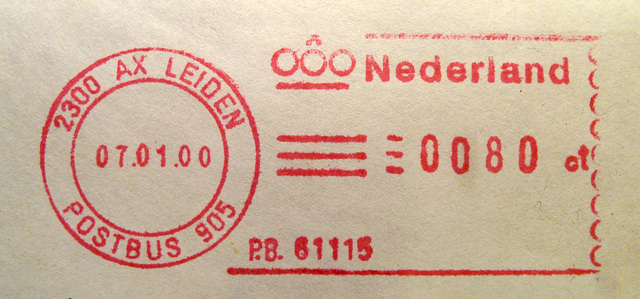Pitney Bowes “Connect+” franking machine impressio…
UKR[2] - another PB meme
O&S[meme] - Paddington
Dutch franking machine impression – Pitney Bowes P…
Dutch franking machine impression – Pitney Bowes P…
Dutch franking machine impression – Pitney Bowes A…
Dutch franking machine impression – Pitney Bowes d…
Dutch franking machine impression – Dutch franking…
1964 Vauxhall Velox PB - 957 LOJ
PB_Behind_Flying_Saucers
PB_Warped_Women
PB_Prison_Nurse
See also...
Keywords
Authorizations, license
-
Visible by: Everyone -
All rights reserved
-
303 visits
Dutch franking machine impression – Pitney Bowes Paragon


When the Uniform Penny Post was introduced in 1840 in the United Kingdom, sending letters became very popular. Some years later, in 1873, the General Postal Union was established, making sending letters abroad easier. The success created problems too, because all these letters needed stamps and people to affix the stamps and other people to cancel the stamps. Stamps could also be stolen. This let to the invention of the franking machine, basically a machine that could make postage impression on letters and a counting device, which kept track of the postage used. Franking machine impressions didn’t need to be cancelled, that saved time.
The first franking machine was patented in 1884, but it took until 1921 until the franking machine was accepted by the Universal Postal Union. Franking machines were also used by post offices, for use at the counters.
Before the introduction of the euro Dutch franking machine impressions had elegant designs. Each manufacturer had a different design, some just line art, others had postal horns, the winged petasus (hat worn by Mercury), carrier pigeons or crown. See below for a good example:

"Netherlands stamp type CB1" by Richard Stambaugh - Richard Stambaugh. Licensed under Public Domain via Wikimedia Commons.
When the euro was introduced, the Dutch postal authorities enforced a similar design for the value section for all franking machines. The name of the Dutch postal authority became part of the impression.
In 2007 the Dutch postal authorities only allowed digital meters, which could connect to the Post Office to download postage and the correct rates. Up till then franking machines were like gas meters. The Post Office visited everybody with a franking machine periodically to see how much postage was used and to check whether the seals hadn’t been broken. The impression of the new digital meters had no special design anymore, just a barcode which could be read by sorting machines.
For other examples of Dutch franking machines impressions, see here:
en.wikibooks.org/wiki/International_Postage_Meter_Stamp_Catalog/Netherlands
The first franking machine was patented in 1884, but it took until 1921 until the franking machine was accepted by the Universal Postal Union. Franking machines were also used by post offices, for use at the counters.
Before the introduction of the euro Dutch franking machine impressions had elegant designs. Each manufacturer had a different design, some just line art, others had postal horns, the winged petasus (hat worn by Mercury), carrier pigeons or crown. See below for a good example:

"Netherlands stamp type CB1" by Richard Stambaugh - Richard Stambaugh. Licensed under Public Domain via Wikimedia Commons.
When the euro was introduced, the Dutch postal authorities enforced a similar design for the value section for all franking machines. The name of the Dutch postal authority became part of the impression.
In 2007 the Dutch postal authorities only allowed digital meters, which could connect to the Post Office to download postage and the correct rates. Up till then franking machines were like gas meters. The Post Office visited everybody with a franking machine periodically to see how much postage was used and to check whether the seals hadn’t been broken. The impression of the new digital meters had no special design anymore, just a barcode which could be read by sorting machines.
For other examples of Dutch franking machines impressions, see here:
en.wikibooks.org/wiki/International_Postage_Meter_Stamp_Catalog/Netherlands
- Keyboard shortcuts:
Jump to top
RSS feed- Latest comments - Subscribe to the comment feeds of this photo
- ipernity © 2007-2024
- Help & Contact
|
Club news
|
About ipernity
|
History |
ipernity Club & Prices |
Guide of good conduct
Donate | Group guidelines | Privacy policy | Terms of use | Statutes | In memoria -
Facebook
Twitter

Sign-in to write a comment.